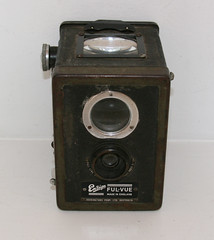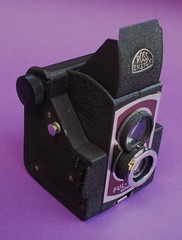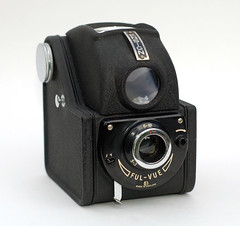Ensign Ful-Vue

|
| Ful-Vue, the alternate British box camera design with the big viewfinder, introduced in 1946 by Barnet Ensign. |

|
| Early Ful-Vue: already with big finder |
cit: "The Ful-Vue camera is really a very simple camera. It consists of a light-tight box. In front of the box there is a hole, over which the lens is fixed. Behind this whole is the shutter. There is a second lens in a second box above it. This produces a picture on the viewfinder on top of the camera. In the back of the box is another hole covered by a red window. This helps you in winding the film on, which you do by the knob at the side of the box near the top." [Marcel Natkin].

|
| Ful-Vue Super |
The earliest Ful-Vue version of 1939 was a typical box camera with back door, but already having the characteristic big viewfinder. Like other box cameras it had a back door and an inner camera part which could be taken out of the box to load the film. In 1946 the camera was redesigned, getting away from average box camera design. Then the inner part of the camera was fixed to the side panel with the film winding knob. The whole unit could be pulled out of the camera sidewards after unlocking it with the knob on the other side panel.
Shutter speed was 1/30 sec. in instant mode and B in time mode. Focusing was possible by pulling the lens out for close exposures. Pictures were 6×6cm on 620 film.
In 1950 further improvements were made, the new shutter, the turnable lens barrel allowing three different distance settings instead of two, an all plastic front panel, and flash synchronization. The improved version was called Ful-Vue II. This was succeeded in 1954 by the Ross-Ensign Ful-vue Super, which had a flat front plate extending around both lenses, a cast alloy body (in place of the sheet steel) and a collapsible hood around the viewfinder. Its red window was closable. The film loading was eased another time by means of the removable back-and-bottom part which was held just by the clamp on the bottom.
The Ful-Vues used 620 film. Especially the Barnet-Ensign variant is easily adaptable to 120 film rolls by simply bending the long metal strip that is part of the rollholder.
The complete Ful-Vue series serves as a model for TTV cameras, cameras used for taking digital images through their amazingly big finders (through-the-viewfinder photography).

|
| 1950s version, with plastic front and distance scale |
Links
- the Ful-Vue at www.ensign.demon [1]
- Full-Vue and User manual at www.collection-appareils.com
- Flickr Group ful-vue
Literature
- Natkin, Marcel: Ful-Vue Guide. London and New York 1949 (2nd. edition 1951, 3rd ed. 1952., 4th ed. 1953)